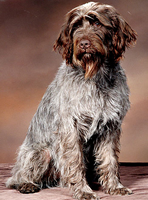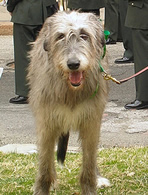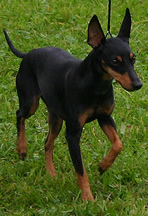
The Siberian Husky is a very strong and muscular dog that is used for hard
labor. The breed comes in a wide variety of colors from solid black to pure
white. The markings on its head also vary in color combinations. Some of the
more common combinations are Red and White, Gray and White, Agouti and White
and Sable and White. However, these combinations still have further variations,
making the breed’s coat very interesting to look at. This impressive
coat consists of a thick undercoat and a soft outer coat that can withstand
temperatures as low as -50 to – 60 degrees Celsius. The feet of this
dog, which is called “snow shoe feet”, also has hair between the
toes to provide it with better traction on snow and ice surfaces. The eyes
of the Siberian Husky are equally fascinating. Just like their coat, the eyes
of this breed vary in color and even in combination. It has always been assumed
that the eyes of the Siberian Husky are predominantly blue. On the contrary,
their eyes can also be brown or amber, or even a combination of all three.
One eye can be half blue and half brown – this condition is referred
to as being parti-eyed. The Siberian Husky can also be bi-eyed, meaning it
can have one blue eye and another eye of a different color. It has ears that
are tall and erect and a sickle shaped tail.
Life Expectancy:
12-15 years
Energy Level:
Average.
Living Conditions:
Cool climates. No small apartments.
Barking:
Average.
Exercise Needs:
Daily 30 minute walk; yard play. Avoid in summer.
Breed Group:
Working
Size:
Medium
Height:
20 - 24 inches
Weight:
40-55 pounds
Standard Hair Colors:
Ranges from solid black to pure white with markings of various color combinations.
National breed club:
The Siberian Husky Club of America
The Siberian Husky was originally used by the Siberian Chukchi people to herd reindeers, pull sleds and fulfill watch-dogging duties. They were the perfect breed for the said jobs because of their exceptional strength and resilience, as well as their ability to withstand the harsh weather conditions of the country. Thus, it came as no surprise when a certain Admiral Byrd used the breed for his Antarctic expeditions. In 1925, the Siberian Husky became famous because of its speed and efficiency in bringing much-needed medicine to the diphtheria-stricken city of Nome, Alaska. The breed is still popular until today, especially for sledding, carting and racing. However, they have also become known as good companion dogs.
The Siberian Husky is a very strong-willed and intelligent breed. While they are highly trainable, they will only carry out a command once they see the point of the order. However, with proper and patient guidance, the Siberian Husky can be cheerful and genuinely affectionate toward the owner and his family. They always seek adventure and love to roam around and explore its surroundings, making them ideal jogging companions. This dog should not be left alone, though, as it gets bored easily and has the tendency to become destructive.
The Siberian Husky requires a fair amount of exercise, preferable in a large yard with a high fence. The base of the fence must be buried securely under the ground because the dog may dig under it and go off hunting. Exercise should be done moderately during warm seasons, because the Siberian Husky may not be able to normally release heat from its body because of its thick coat.
Since Siberian Huskies have thick, woolly coats, they are ideal for people who live in areas with cool climates. Should the owner live in a tropical country, air-conditioning for the dog is a must. They are also not recommended for those who have small living quarters, not unless they are properly trained and regularly exercised in vast areas.
The Siberian Husky requires minimal grooming. However, its coat must be combed thoroughly during its heavy shedding periods, which occurs twice a year.
The Siberian Husky is a relatively healthy breed. However, it can be prone to hip dysplasia, eye problems and zinc responsive dermatitis.
You may also take a liking to the Samoyed, which is a close cousin of the Siberian Husky. This breed, which is equally intelligent as its colorful cousin, is perfect for those who live in areas with cool climates.

 Wirehaired Pointing Griffons: A guide to dogs and puppies of the Wirehaired Pointing Griffon breed
The Wirehaired Pointing Griffon!
The Wirehaired Pointing Gr
Wirehaired Pointing Griffons: A guide to dogs and puppies of the Wirehaired Pointing Griffon breed
The Wirehaired Pointing Griffon!
The Wirehaired Pointing Gr
 Ibizan Hound
Ibizan Hound
Ibizan Hound
Ibizan Hound
 Bluetick Coonhound Breed Profile - Choosing a Bluetick Coonhound
Bluetick Coonhound Breed Profile - Choosing a
Bluetick Coonhound Breed Profile - Choosing a Bluetick Coonhound
Bluetick Coonhound Breed Profile - Choosing a
 Irish Wolfhounds: A guide to dogs and puppies of the Irish Wolfhound breed
The Irish Wolfhound!
The Irish Wolfhound is one of the tall
Irish Wolfhounds: A guide to dogs and puppies of the Irish Wolfhound breed
The Irish Wolfhound!
The Irish Wolfhound is one of the tall
 Manchester Terriers: A guide to dogs and puppies of the Manchester Terrier breed
The Manchester Terrier!
Two strains of the Manchester terri
Manchester Terriers: A guide to dogs and puppies of the Manchester Terrier breed
The Manchester Terrier!
Two strains of the Manchester terri
Copyright © 2005-2016 Pet Information All Rights Reserved
Contact us: www162date@outlook.com